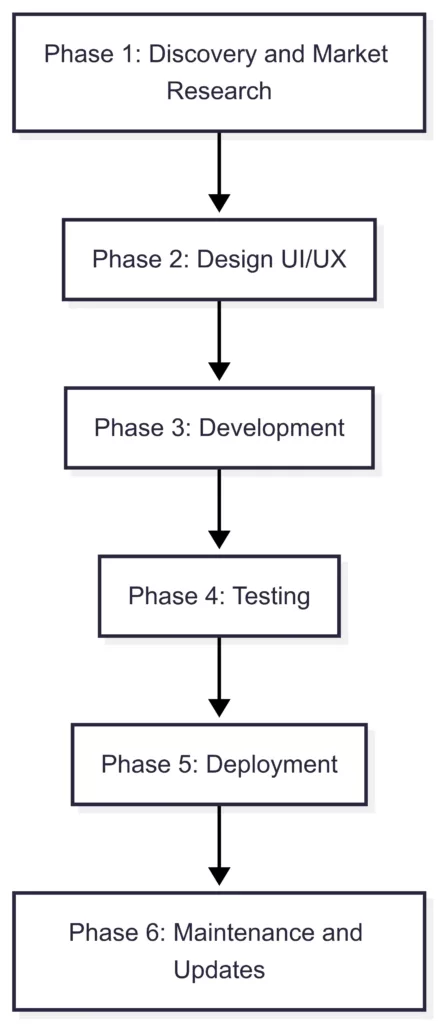In 2025, mobile app development is essential for businesses, especially in tech-savvy Singapore. A common question is: What is the app development cost in Singapore?
In app development, the cost varies widely, influenced by factors like app complexity, design uniqueness, and developer expertise. In Singapore, developing a mobile app typically ranges from SGD 10,000 to SGD 500,000+. Meanwhile, advanced apps start at around SGD 85,000.
Despite the high costs in 2025, investing in a well-designed app can significantly benefit businesses by enhancing customer engagement and driving revenue growth.

Table of Contents
Estimated Information on App Development Costs in Singapore
The cost of mobile app development in Singapore has seen some fluctuations over the years. Here’s a brief overview based on the available data on the last 5 years, from 2020 to 2024:
- In 2020, the cost of developing a basic mobile app in Singapore was around SGD 20,000. However, the cost could range between SGD 20,000 to SGD 90,000 depending on the complexity and novelty of the features.
- In 2021, a simple app for a single platform might start at around SGD 10,0003. However, if you factor in content strategy, user experience, UI/UX design, and backend, the cost could be around SGD 90,000.
- In 2022, the estimated cost of developing a basic application ranged between SGD 15,000 to SGD 50,000. If additional features were required, the cost could increase from SGD 20,000 to SGD 65,000.
- By 2023, the cost of developing a simple app was estimated to be between SGD 22,000 and SGD 45,000. For a medium-complexity app, the budget ranged from SGD 43,000 to SGD 65,000. A complex app development project could require an investment of SGD 100,000 or more.
- In 2024, the cost of developing an application could range anywhere from SGD 10,000 to SGD 150,000+ depending on the complexity, requirements, and skills needed to develop it.
The cost of mobile app development cost in Singapore has fluctuated over the years, with a noticeable upward trend from 2020 to 2024. This rise is likely due to the growing demand for mobile apps, technological advancements, and increasing costs of resources and expertise. While average costs provide a general idea, the actual expense can vary based on factors such as app complexity, required features, and the development team’s expertise. For a precise estimate, it’s best to obtain a detailed quote from an app development company.
Factors Affecting Mobile App Development Costs in Singapore
Understanding the cost of developing an app involves more than just looking at the final price tag. It’s about understanding the various factors that contribute to that cost. In this section, we will delve into the key elements that influence the cost of mobile app development in Singapore. From the complexity of the app and the expertise of the development team to the choice of technology and post-launch support, each of these factors plays a crucial role in determining the overall cost of developing a mobile app. Let’s take a closer look at these factors to give you a clearer picture of what goes into the cost of app development.
App Complexity
The complexity of an app is one of the most significant factors that influence its development cost. This includes the number of screens, user roles, and the complexity of business logic. An app with simple functionality, like a calculator, will cost less compared to a multi-faceted e-commerce app or a social networking app.
Simple Apps: These are basic applications with minimal features, a straightforward user interface, and limited backend functionality. They are often used for MVPs (Minimum Viable Products) or internal tools.
- Cost Range: SGD 15,000 – SGD 30,000
Medium Complexity Apps: This category includes apps with more advanced features, such as user profiles, payment gateways, social media integration, and real-time notifications.
- Cost Range: SGD 30,000 – SGD 80,000
Complex Apps: These are highly sophisticated applications with extensive features, complex backend infrastructure, AI/ML integration, real-time data synchronization, and high-level security. This category also includes enterprise-grade and multi-service “super apps.”
- Cost Range: SGD 80,000 – SGD 200,000+
UI/UX Design
The user interface (UI) and user experience (UX) design of an app play a crucial role in its success. A well-designed app provides a seamless experience for its users, which can lead to higher user engagement. However, creating a unique and intuitive design requires a significant amount of time and expertise, which can add to the development cost.
According to industry analysis, the investment in UX design varies but is often a significant portion of a software development budget. For many projects, particularly in the seed stage, software development companies allocate around 20% of the total budget to UX design.
The return on investment (ROI) for good design is well-documented. A well-designed user interface (UI) has been shown to increase conversion rates by up to 200%. Furthermore, an excellent user experience (UX) can more than double this figure, with some studies showing an increase in conversion rates of up to 400%. This highlights how a strategic investment in UX and UI design can lead to substantial business growth and revenue.
Platform Choice
The choice of platform—iOS, Android, or both—is a key factor in app development costs in Singapore. While developing for both platforms using separate, native codebases will significantly increase costs, cross-platform development tools (such as Flutter or React Native) make it possible to build apps for both iOS and Android from a single codebase.
This approach is popular because it generally leads to a significant reduction in both development time and cost, with some studies indicating a 30-50% saving compared to developing two separate native applications. This efficiency is a major benefit for businesses aiming for a faster time-to-market and a broader audience reach.
Features and Functionality
The features and functionalities of an app are directly proportional to its development cost. While basic features like user login are relatively inexpensive to implement, more complex functionalities like payment integration, GPS tracking, or chatbots can significantly increase the cost due to the extended development hours and resources required.
For instance, the development cost for a basic dating app with core features such as user profiles and a simple swiping mechanism starts around $20,000. However, the cost can rapidly increase to $120,000 or more for apps with more complex functionalities like AI matchmaking, real-time chat, and video calls. Advanced features and dual-platform development (iOS and Android) can push costs well upwards of $150,000 for a full-featured, enterprise-level application.

Common Types of Mobile Apps in Singapore
Singapore, known for its high-tech environment and digitally savvy population, has a dynamic mobile app market. The types of apps that are popular in Singapore reflect the lifestyle and needs of its residents. Here are some of the common types of mobile apps in Singapore, along with some statistics to illustrate their popularity:
Social Media Apps
Social media apps are incredibly popular in Singapore, with a user base that continues to grow. As of early 2025, Singapore was home to 5.16 million social media user identities. This figure equates to a high penetration rate of 88.2% of the total population, placing Singapore among the most digitally connected nations globally.
Platforms like Facebook, Instagram, and TikTok remain widely used for communication, entertainment, and information sharing, with residents spending an average of 2 hours and 2 minutes on social media platforms daily. Notably, the average number of social media platforms used per person is also increasing, indicating that Singaporeans are spreading their attention across more apps.
Transport Apps
Transport apps are essential for navigating the city-state. Apps like MyTransport.SG and Citymapper provide real-time updates on public transport schedules, routes, and fares. In the ride-hailing sector, Grab remains the most popular choice, offering a convenient and widely-used way to book rides. The company’s market dominance is supported by its super-app strategy, which integrates ride-hailing with food delivery, mobile payments, and other services.
Food Delivery Apps
With the continued growth of the food delivery industry, apps like GrabFood, Foodpanda, and Deliveroo remain a staple in many Singaporeans’ lives. These platforms offer a wide range of cuisines, catering to the diverse food preferences of the city-state’s population.
Key Market Trends and Statistics (2025)
The food delivery market in Singapore is experiencing robust growth, driven by a desire for convenience and a highly digital-savvy population. Here are some key points for 2025:
- Dominant Players: GrabFood continues to hold a leading position in the market. The competitive landscape remains dynamic, with Foodpanda and Deliveroo also being major players. Grab and ShopeeFood have recently intensified their focus on budget-friendly initiatives to attract a broader customer base.
- Online Sales Value: The total sales value of food and beverage services in Singapore was estimated at $962 million in June 2025. Of this, an estimated 26.7% were from online sales, reflecting the significant role of food delivery apps.
- Market Growth: Singapore’s online food delivery market is projected to reach approximately USD 966 million by 2030, growing at a Compound Annual Growth Rate (CAGR) of 8.33% from 2024 to 2030.
- User Penetration: The user penetration rate for meal delivery in Singapore is forecasted to reach an impressive 57.6% by 2025, indicating that more than half of the population regularly uses these services.
E-commerce Apps
E-commerce apps have seen a surge in popularity, with platforms like Shopee, Lazada, and Amazon being widely used for online shopping. These apps offer a convenient and seamless shopping experience, with a wide range of products available at the click of a button.
- Market Leadership: As of 2025, Shopee remains the top e-commerce platform in Singapore, with a significant lead in monthly web traffic and user engagement. Lazada and Amazon are its primary competitors, with Amazon showing particular strength in categories like electronics and books, and strong global selling capabilities. New entrants and “super apps” like TikTok Shop and Temu are also disrupting the market, challenging the long-standing dominance of the established players.
- Mobile-First Dominance: Singapore’s tech-savvy population and high mobile penetration rate mean that mobile commerce is the preferred way to shop. E-commerce platforms are focusing on mobile-first user interfaces, seamless navigation, and features like biometric authentication and one-tap payments to enhance the shopping experience.
- Market Size: The e-commerce market in Singapore is projected to grow significantly. Different reports show varying figures, but a common forecast is that the market’s gross merchandise value (GMV) will exceed USD 10 billion by 2025.
- Cross-Border Shopping: Singaporean consumers are increasingly engaging in cross-border shopping, with a significant percentage of online purchases made from international websites. This is driven by the desire for better deals and unique products, with platforms like Amazon’s global marketplace and AliExpress playing a key role.
Entertainment Apps
Entertainment apps, particularly video-sharing platforms like YouTube and TikTok, are among the most widely used in Singapore. In 2023, Singaporean Android users spent the most time on entertainment and video-sharing apps, with about 1.07 billion hours spent.
- Platform Dominance: TikTok continues to capture a significant share of user attention, with users spending an average of 34 hours and 29 minutes per month on the platform. This highlights its dominance in the short-form video space. YouTube remains a major player, with users clocking in an average of 29 hours and 45 minutes per month, showing its continued importance for a wide variety of long-form content.
- Broad Social Media Usage: While entertainment apps are a major driver of engagement, Singaporeans are also spending a significant amount of time across all social media platforms. The average daily social media usage is 2 hours and 2 minutes, and users engage with an average of 7.2 different platforms each month. This suggests a fragmentation of attention rather than a decline in interest.
- Content Consumption: Beyond just entertainment, video-sharing platforms are increasingly used for a variety of purposes. A significant portion of Singaporean internet users (54.2%) watch videos, TV shows, or movies online. These platforms are also key for discovering new brands and restaurants, with a growing number of users following food and entertainment accounts.
Detailed Process of iOS/Android App Development
Developing a mobile app, whether it’s for iOS or Android, involves several stages. Each stage comes with its own set of tasks, complexities, and costs. Here’s a breakdown of the typical app development process and the associated app development costs in Singapore:
1. Discovery and Market Research
This initial stage involves understanding the market, the target audience, and the competition. It also includes defining the app’s concept and its unique selling proposition. The cost of this stage can range from $1,000 to $5,000.
2. Design (UI/UX)
The design phase involves creating the user interface and user experience. This includes designing the app’s layout, screens, and visual elements. The cost of this stage can vary significantly based on the complexity of the design, ranging from $5,000 to $15,000.
3. Development
This is the most labor-intensive stage, where the actual coding of the app takes place. The cost of this stage depends on the complexity of the app and the hourly rate of the developers. On average, the development cost for an Android app ranges from $5,000 to $500,000.
4. Testing
Once the app is developed, it goes through rigorous testing to ensure it’s bug-free and provides a smooth user experience. The cost of this stage can range from $2,000 to $10,000.
5. Deployment
This involves launching the app on the App Store or Google Play Store, which includes the cost of setting up the developer account and the app submission process. The cost of this stage is relatively low, typically around $100 for the App Store and $25 for Google Play Store.
6. Maintenance and Updates
After the app is launched, it needs regular updates and maintenance to keep it running smoothly and to add new features. This is an ongoing cost, and an app maintenance cost in Singapore can range from 15% to 20% of its total development cost per year.

Tips to Reduce Mobile App Development Costs
Developing a mobile app can be a costly endeavor, but several strategies can help reduce these mobile app development services costs without compromising on quality. Here are some tips to consider:
- Plan Thoroughly: A well-defined plan can help prevent costly changes and reworks in the later stages of development. Spend time on market research, defining your target audience, and outlining your app’s features and functionality.
- Start with MVP: A Minimum Viable Product (MVP) is a version of your app with just the essential features. It allows you to test your app in the market and gather user feedback without investing heavily in full-scale development.
- Choose the Right Platform: If your target audience is primarily on one platform (iOS or Android), consider starting with that platform first. Cross-platform development tools can also help reduce costs by allowing you to develop for both platforms simultaneously.
- Leverage Existing Technologies: There are numerous open-source libraries and third-party services available that can help speed up development and reduce costs. However, ensure these technologies align with your app’s requirements and quality standards.
- Regular Testing: Regular testing throughout the development process can help identify and fix issues early, preventing costly fixes in the later stages.
- Outsource Wisely: If you’re considering outsourcing your app development, choose a reputable company with a proven track record. While it might be tempting to go with the cheapest option, poor-quality work can end up costing more in the long run.
In conclusion, while it’s crucial to manage your budget effectively, the quality of your app should never be compromised. A well-crafted, user-friendly app can yield a substantial return on investment over time.
Gaining insights into the factors that can influence your mobile app development cost is invaluable. It equips you with the knowledge needed to strategize your app-building budget effectively.
If you’re seeking assistance, consider partnering with us at Vinova. With our decade-long experience in mobile app development, we assure you that you’re in capable hands when it comes to building high-quality apps at a reasonable price. Reach out to us today and let’s bring your app idea to life! With the best price in Singapore possible.